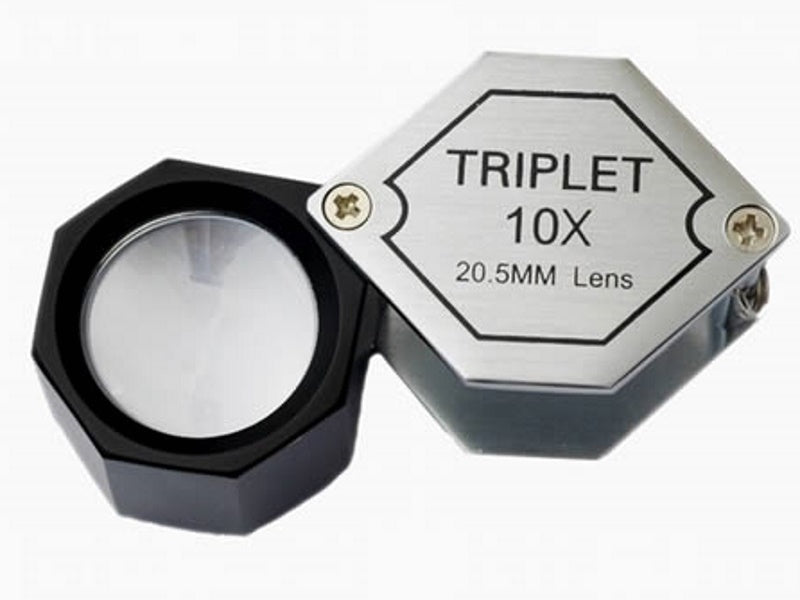
How to Use a Jeweller's Loupe
Welcome to the fascinating world of jewellery examination! Whether you're a hobbyist, an aspiring jeweller, or a beginner eager to delve into the details of gemstones and jewellery pieces, mastering the use of a jeweller's loupe is an essential skill. It not only enhances your ability to appreciate fine details but also aids in the accurate examination of jewellery. This guide will walk you through everything you need to know about using a jeweller's loupe effectively.
What is a Jeweller's Loupe?
A jeweller's loupe is a small, powerful magnification tool used primarily to closely examine gemstones, settings, and other intricate details in jewellery. Unlike standard magnifying glasses, a loupe does not have a handle, and its lenses are specifically designed to offer a close-up view at a short focal point. This close examination is crucial for identifying fine details and ensuring the quality of gemstones and their settings. Loupes typically offer magnifications ranging from 10x to 30x, with 10x being the most common as it balances detail with a broader view.
Choosing the Right Loupe
When selecting a jeweller's loupe, consider the following to ensure it meets your examination needs:
- Magnification: A 10x magnification is usually sufficient for detailed jewellery examination and is the standard in the industry. Higher magnifications can be used for micro details, but they may restrict the field of view.
- Lens Quality: Choose loupes with high-quality lenses that provide a clear, distortion-free view. Achromatic lenses are preferred as they reduce colour distortion, and triplet lenses help to minimize optical aberrations.
- Portability and Design: Consider whether you prefer a foldable loupe for easy storage and protection or a loupe that attaches to eyeglasses for hands-free use, which can be particularly helpful during extended examination sessions.
Getting Started
- Hold the Loupe Correctly: Hold the loupe close to one eye, and close the other eye. This might feel awkward at first, but it’s the standard way to use a loupe. The loupe should be near enough to your eye that your eyelashes can almost touch it when you blink.
- Position the Item: With your free hand, bring the jewellery piece to the loupe, not the other way around. Start by positioning the item about an inch away from the loupe. Adjust the distance until you get a clear view.
- Focus and Lighting: Good lighting is critical for effective examination. Use a strong, direct light source to illuminate the item from various angles. Adjust your position and the angle of light until you achieve the clearest view of the details you are examining.
What to Look for
- Gemstone Examination: Check for scratches, inclusions, and irregularities. Notice the color uniformity and the precision of the cut.
- Setting and Mounting Checks: Examine the security of the setting. Look for any signs of metal fatigue, improper alignment, or damage to prongs and bezels.
- Hallmarks and Engravings: Identify any maker’s marks, hallmarks, or engravings that can give you insights about the authenticity and origin of the piece.
Common Mistakes and How to Avoid Them
Avoiding Common Errors
- Too Much Magnification: Using a loupe with too high a magnification can make it difficult to examine an item effectively, as the field of view is too narrow. Stick to a 10x magnification for a good balance.
- Poor Lighting: Avoid using the loupe in poorly lit conditions. Adequate lighting is crucial for spotting fine details.
- Incorrect Holding Technique: Don’t hold the loupe too far from your eye or the item too far from the loupe. This common mistake can lead to a blurry image and increased eye strain.
Maintaining Your Loupe
Care and Maintenance
- Cleaning the Lens: Use a soft, lint-free cloth to clean the lens. Avoid harsh cleaning chemicals that can damage the lens coating.
- Storage: When not in use, store your loupe in a case to protect it from scratches and dust. Avoid leaving it in direct sunlight or in extreme temperatures.
- Regular Checks: Regularly check the loupe for damage to the lens or frame. Ensuring your loupe is in good condition will provide the best results during examinations.
Conclusion
Mastering the use of a jeweller's loupe takes practice, but it's an invaluable tool in the jewellery enthusiast's kit. By understanding how to choose the right loupe, use it effectively, and maintain it properly, you can enhance your ability to examine intricate details and ensure the quality of your jewellery pieces.
